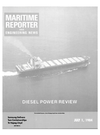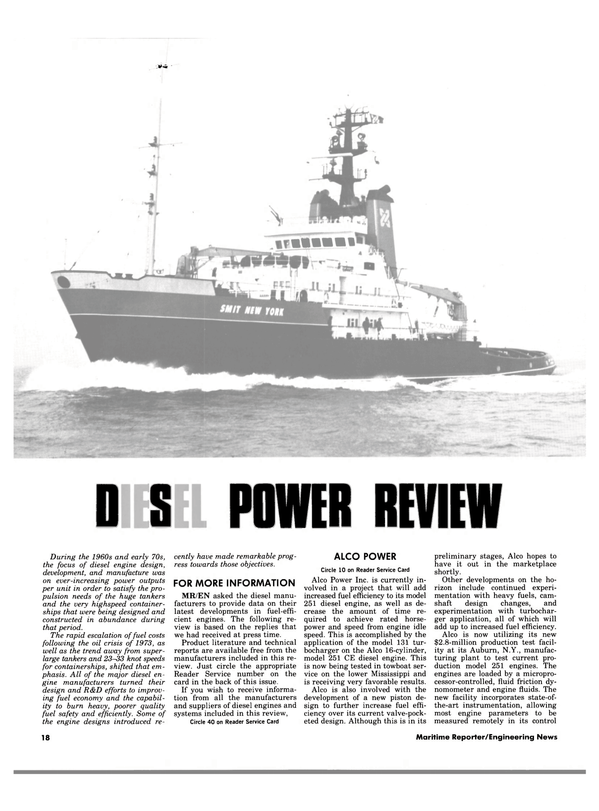
Two Samsung-built Hapag-Lloyd Ships Feature Unique Asymmetric Stern
The Koje Shipyard of Samsung Shipbuilding & Heavy Industries Company, Ltd. in Korea recently delivered two multi-purpose containerships to Hapag-Lloyd A.G.
of Hamburg, the West German shipping company that operates worldwide services. Christened Humboldt Express and Cordillera Express, they each have a capacity of 1,938 TEUs in six cellular cargo holds and on deck. These sophisticated vessels were designed and built under the rules of Germanischer Lloyd, and are classed + 100A4, E, MC, AUT, Multi-purpose Container Vessel.
These ships are diesel-propelled, single-screw cellular containerships of 34,000 dwt. A traveling gantry crane is installed on the main deck for self-loading/unloading of boxes and breakbulk cargoes, making them independent of shoreside cranes. With a con-air ducting system installed, they can carry up to 262 TEUs of reefer containers in the hold, and up to 100 TEUs of integral reefer boxes as deck cargo.
The ship has an overall length of 675.14 feet, beam of 105.64 feet, depth to main deck of 61.68 feet, and design draft of 30 feet. Accommodations are provided for a crew of 33, all in private cabins that were installed as prefabricated units.
Humboldt Express is propelled by a low-speed Hyundai/B&W 5L90GBE diesel engine with a maximum continuous rating of 19,800 bhp at 97 rpm, direct-connected to a five-bladed, highly skewed Ostermann propeller via Kobe Steel shafting. Operating at 85 percent of mcr, service speed on a draft of about 30 feet is 18.4 knots. Cruising range at the service speed is 20,000 nautical miles.
The main propulsion engine is designed to burn heavy fuel oil at a rate of 46.5 metric tons per day.
The most -unique feature of these new Hapag-Lloyd ships is the asymmetric afterbody hull form, newly developed by Ernst A. Nonnecke of Hamburg in cooperation with the Hamburg Ship Model Basin. Though it looks unconventional below the waterline, the new stern has already proven its advantage in cutting fuel costs by up to 10 percent.
The ships now being built with the asymmetric stern are all destined for German owners. In addition to the Hapag-Lloyd ships, nine vessels are being built in Brazil for three different German owners, all with a capacity of 700 TEU. The first vessel built with this unique afterbody was a 502- TEU containership constructed at the Heinrich Brand Shipyard in Oldenburg, West Germany. An ice class cargoliner is being built at the same shipyard, and several other vessels that will have the asymmetric stern are now being constructed or programmed for German owners.
Though the asymmetric stern is slightly more complex and therefore a little more expensive to construct, the extra cost of the ship is recovered rapidly in fuel savings.
As international shipowners become increasingly aware of the German development, the asymmetric stern may well become as common as the bulbous bow is today.
Development work on the new stern design has taken place at the Hamburg model basin over the past 10 years, but it is only the recent steep rise in fuel costs that has brought its advantages home to German shipowners.
Electric power for the Hapag- Lloyd ships is provided by Fuji equipment—two 1,500-kw diesel generators, one 2,200-kw generator, and one 115-kw emergency generator. Steam generation is by an Aalborg oil-fired boiler and an exhaust gas boiler. Two ballast pumps each have a capacity of 600 cubic meters per hour.
Navigation equipment includes two radars, a satellite navigation system, two gyrocompass/autopilots, a magnetic compass, and a weather facsimile unit. The main radio is a 1.5-kw SSB; a VHF radiotelephone is also provided.
Read Two Samsung-built Hapag-Lloyd Ships Feature Unique Asymmetric Stern in Pdf, Flash or Html5 edition of July 1984 Maritime Reporter
Other stories from July 1984 issue
Content
- Tacoma Boat Awarded $110-Million Contract To Build Passenger Liner page: 4
- Williams Announces Lubricating Innovation For Steel Cables page: 5
- Hitachi Zosen Delivers Bulk Carrier To Greek Owner page: 5
- Cummins Engine Announces New Engine Model Codes For Marine Product Line page: 5
- Desco Marine Adds Three New Fiberglass Hulls To Line of Fishing Boats page: 6
- Two Appointments Announced By Marathon Marine page: 6
- Engineering Partnership Formed By Kongsberg And McDermott International page: 6
- Deutsch Metal Offers Free Pyplok Catalog page: 6
- Unique Mini-Liner Nearing Completion At Bender Shipbuilding Yard In Mobile page: 7
- Bender Delivers 98-Foot New Bedford Scalloper page: 7
- Daewoo To Build Offshore Gas/Oil Production Plant page: 8
- Joseph Cangelosi Forms New Consulting Firm page: 8
- Dockside Signs Contract With M.A.N./B&W Service — Rennie Joins Staff page: 8
- Philadelphia Gear Supplies New Propulsion Drives For San Francisco Ferry Boats page: 8
- Gennaro Oliva Joins Atlantic Coast Enterprises page: 8
- Marathon LeTourneau Offshore Announces Major Reorganization page: 9
- Bob Daniels Named New Marland President & CEO page: 9
- NABRICO Names Gower VP-Engineering page: 9
- American-Standard Offers Free Bulletin On FanEX® Air/Oil Heat Exchangers page: 9
- CDI Marine Appoints Smith And Dodson page: 10
- Sonat Subsea Services Appoints Senior VP page: 10
- New Raytheon SSB Is Microprocessor Controlled —Literature Available page: 10
- Comsat TeleSystems Introduces The MCS-9100 Ship Earth Station page: 12
- Socal Announces Executive Changes page: 12
- NOR-FISHING '84 page: 12
- Rockwell International Announces Key Top Management Promotions page: 13
- New Remote Control Subsea Gyrocompass Introduced By Robertson page: 13
- MarAd Acquires RO/RO Vessel Atlantic Bear With Bid Of $17.5 Million page: 14
- NASSCO Holds Naming Ceremonies For Two Ship Conversions page: 14
- Perolin Offers Handbook On Fuel Oil Treatment page: 14
- Two Samsung-built Hapag-Lloyd Ships Feature Unique Asymmetric Stern page: 16
- OFFSHORE NORTHERN SEAS page: 16
- DIESEL POWER REVIEW page: 18
- SCANDINAVIAN SHIPBUILDING page: 23
- Magnavox MX 1100 Series Navigators GPS Upgradable —Literature Available page: 34
- Ingram Materials Expands Bulk Marine Terminal page: 35
- Emerson Shank Joins Desco Marine As VP Sales And Marketing page: 35
- Navy Adding 19 Ships To Ready Reserve Force page: 36
- AMR™ Is New Name For Transamerica Delaval Line Of Three-Screw Pumps page: 37
- Caterpillar Offers Remanufactured Fuel Nozzles And Tune-Up Kits page: 37
- SNAME Issues Call For Papers For 1985 OTC page: 38
- Comsat Dedicates Roaring Creek Earth Station page: 38
- Norcontrol Renews Long-Term Agreement With B&W Diesel page: 41
- Integrated Marine Electronic Systems Nav-Com Inc., Seminar—Washington, D.C. page: 42
- Oceaneering International Dual Hydra Rov Systems At 100 Percent Utilization page: 49
- Fast Navy Supply Ship Capella Dedicated At Pennsylvania Shipbuilding page: 50


